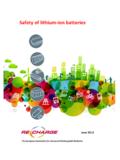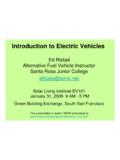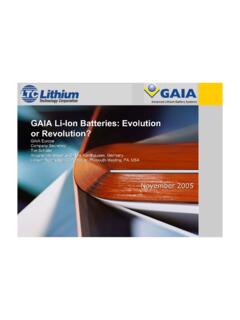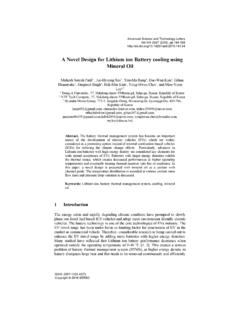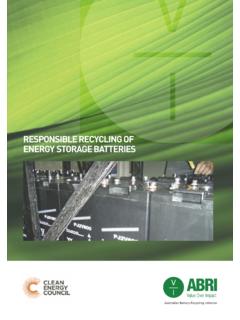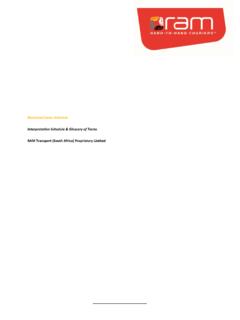Transcription of Batteries Carried by Airline Passengers FAQ - …
1 Batteries Carried by Airline Passengers Frequently Asked Questions Q1. What kinds of Batteries does the FAA allow in carry-on baggage (in the aircraft cabin)? A1. For carry-on baggage checked at the gate or planeside, see Q2, below. Passengers can carry most consumer-type Batteries and portable battery-powered electronic devices for their own personal use in carry-on baggage. Spare Batteries must be protected from damage and short circuit. Battery-powered devices must be protected from accidental activation and heat generation. Damaged or recalled Batteries , including when in a device, must not be Carried . Batteries allowed in carry-on baggage include: Dry cell alkaline Batteries : typical AA, AAA, C, D, 9-volt, button-sized cells, etc. Dry cell rechargeable Batteries such as Nickel Metal Hydride (NiMH) and Nickel Cadmium (NiCad).
2 For rechargeable lithium ion Batteries ; see next paragraph. Lithium ion Batteries ( : rechargeable lithium, lithium polymer, LIPO, secondary lithium). Passengers may carry all consumer-sized lithium ion Batteries (up to 100 watt hours per battery). This size covers AA, AAA, cell phone, PDA, camera, camcorder, handheld game, tablet, portable drill, and standard laptop computer Batteries . The watt hours (Wh) rating is marked on newer lithium ion Batteries and is explained in #3 below. External chargers are also considered to be a battery. With Airline approval, devices can contain larger lithium ion Batteries (101-160 watt hours per battery), but spares of this size are limited to two Batteries in carry-on baggage only. This size covers the largest aftermarket extended-life laptop Batteries and most lithium ion Batteries for professional-grade audio/visual equipment.
3 Lithium metal Batteries ( : non-rechargeable lithium, primary lithium). These Batteries are often used with cameras and other small personal electronics. Consumer-sized Batteries (up to 2 grams of lithium per battery) may be Carried . This includes all the typical non-rechargeable lithium Batteries used in cameras (AA, AAA, 123, CR123A, CR1, CR2, CRV3, CR22, 2CR5, etc.) as well as the flat round lithium button cells. Nonspillable wet Batteries (absorbed electrolyte), limited to 12 volts and 100 watt hours per battery. These Batteries must be the absorbed electrolyte type (gel cells, AGM, etc.) that meet the requirements of 49 CFR (d); , no electrolyte will flow from a cracked battery case. Batteries must be in strong outer packagings or installed in equipment.
4 Passengers are also limited to two (2) spare (uninstalled) Batteries . Spare Batteries terminals must be protected (non-conductive caps, tape, etc.) within the outer packaging. Batteries and outer packaging must be marked nonspillable or nonspillable battery. Note: This exception is for portable electronic devices, not for vehicle Batteries . There are separate exceptions for powered wheelchairs. Q2. What kinds of Batteries does the FAA allow in checked baggage (including gate-checked bags)? A2. Except for spare (uninstalled) lithium metal and lithium-ion Batteries , all the Batteries allowed in carry-on baggage are also allowed in checked baggage. The Batteries must be protected from damage and short circuit or installed in a device.
5 Battery-powered devices particularly those with moving parts or those that could heat up must be protected from accidental activation. Spare lithium metal and lithium ion/polymer Batteries are prohibited in checked baggage this includes external battery packs. Electronic cigarettes and vaporizers are also prohibited in checked baggage. Checked baggage includes bags checked at the gate or planeside. Q3. How do I determine the watt hours (Wh) rating of a battery? A3. To determine watt hours (Wh), multiply the volts (V) by the ampere hours (Ah). Example: A 12-volt battery rated to 8 Amp hours is rated at 96 watt hours (12 x 8 = 96). For milliamp hours (mAh), divide by 1000 (to get to Ah) and then multiply by the volts. Q4. Is there a limit to the number of Batteries or devices I can carry?
6 A4. The main limit is that the Batteries and devices must be for personal use (includes professional use). Batteries and battery-powered devices Carried for resale or for distribution by a vendor do not qualify for these exceptions. There is a two-spare limit on the large lithium-ion (101-160 Wh) and nonspillable Batteries (see the chart on the next page). Q5. What does protected from short circuit mean? A5. When metal objects such as keys, coins, tools or other Batteries come in contact with both terminals of a battery it can create a circuit or path for electricity to flow through. Electrical current flowing through this unprotected short circuit can cause extreme heat and sparks and even start a fire. To prevent short circuits, keep spare Batteries in their original packaging, a battery case, or a separate pouch or pocket.
7 Make sure loose Batteries can t move around. Placing tape over the terminals of unpackaged Batteries also helps to insulate them from short circuit. For a quick reference guide, see illustrated table on next Federal Aviation Administration Sep 9, 2016 Office of Hazardous Materials Safety Batteries Allowed in Airline passenger Baggage in the US Sep 9, 2016 Type of Battery There is no limit to the number of Batteries or devices Carried for personal use unless specified below. Allowed in carry-on baggage? Allowed in checked1 baggage? In equipment2 Spares In equipment Spares Dry alkaline Batteries YES YES When protected from damage and short circuit YES YES When protected from damage and short circuit Dry rechargeable Nickel Metal Hydride (NiMH), Nickel Cadmium (NiCad), etc.
8 YES YES When protected from damage and short circuit YES YES When protected from damage and short circuit Lithium ion (rechargeable lithium, lithium polymer, LIPO) as used in small consumer electronics, such as cell phones, tablets, tools, cameras, PDAs, and laptops. Limited to 100 watt hours3 or less per battery. YES YES When protected from damage and short circuit YES E-cigarettes and vaporizers are prohibited in checked baggage. NO Larger lithium ion, 101-160 watt hours3 per battery with Airline approval. Limits: Two spare Batteries per passenger with Airline approval. YES Airline approval required YES When protected from damage and short circuit, Airline approval required YES Airline approval required NO Lithium metal (non-rechargeable) as used in small consumer electronics such as cameras, LED flashlights, watches, etc.
9 (2 grams or less lithium per battery). YES YES When protected from damage and short circuit YES E-cigarettes and vaporizers are prohibited in checked baggage. NO Nonspillable wet Batteries (absorbed electrolyte) for portable electronic devices, 12 volts and 100 watt hours3 per battery. YES YES When protected from damage and short circuit and in strong packaging. Battery and outer packaging must be marked nonspillable. YES YES When protected from damage and short circuit and in strong packaging. Battery and outer packaging must be marked nonspillable. 1 Note: Checked baggage includes carryon-bags checked at the gate or planeside. 2 Note: TSA security rules prohibit some power tools in carry-on baggage. 3 Note: Watt hours (Wh) = Volts (V) x Amp hour (Ah) or for milliamp hours Wh = V x (mAh 1000) For more information and for rules on battery-powered wheelchairs or assistive devices, please go to or call the DOT Hazardous Materials Information Center at 1-800-467-4922.
10 For TSA security restrictions please go to Limits: Two spare Batteries per passenger . Based on US DOT regulations (49 CFR, Sec. ). TSA security, individual Airline , and international rules may, at times, be more restrictive. For lithium ion, see below.

